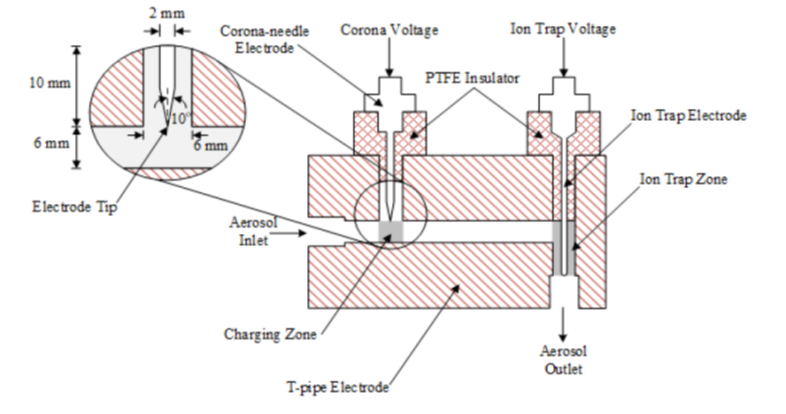


Indian Journal of Science and Technology
Year: 2021, Volume: 14, Issue: 4, Pages: 335-350
Original Article
Panich Intra1*, Paisarn Wanusbodeepaisarn2, Thanesvorn Siri-achawawath3
1Research Unit of Applied Electric Field in Engineering (RUEE), College of Integrated Science and Technology, Rajamangala University of Technology Lanna, Chiang Mai, 50220, Thailand
2Pico Innovation Co., Ltd., 336 M. 4, Yang Noeng, Saraphi, Chiang Mai, 50140, Thailand
3Innovative Instrument Co., Ltd., 7/139 Suntinakorn 11 Alley, Bang Kaeo, Bang Phli, Samut Prakan, 10540, Thailand
*Corresponding Author
Email: [email protected]
Received Date:19 October 2020, Accepted Date:15 January 2021, Published Date:02 February 2021
Objectives: In this study, a unipolar corona discharger was developed and experimentally evaluated for its intrinsic and extrinsic charging efficiencies, and electrostatic and diffusion losses of submicron aerosol particles in the size range of 20–300 nm at different corona and ion trap voltages. Method: The applied voltage of the discharger ranged between 2.4 and 3.2 kV, corresponding to a discharge current of 0.19 nA–2.0 mA, and an ion number concentration of 1.88X1011–1.97X1015 ions/m3. Findings: Increasing the corona voltage could lead to a higher discharge current and ion concentration inside the discharger. In the proposed discharger, intrinsic charging efficiencies of aerosol particles between 76.9% and 93.0% were obtained for particle sizes ranging between 20 and 100 nm for the given corona and ion trap voltages. The extrinsic charging efficiency decreased as the ion trap voltage increased at a given corona voltage. Novelty: The optimal extrinsic charging efficiency of the discharger was observed to be approximately 20.8–58.6% for particle sizes ranging from 20 to 300 nm at a corona voltage and ion trap voltage of approximately 2.8 kV and 200 V, respectively. In this discharger, the highest electrostatic losses (approximately 73.5%, 83.7%, and 54.0%) were observed corresponding to corona voltages of 2.8, 3.0, and 3.2 kV, respectively at a particle diameter of 20 nm and an ion trap voltage of 300 V. Finally, the highest diffusion loss (approximately 18.9%) was observed at a particle diameter of 20 nm.
Keywords: Corona discharge; particle charging; aerosol discharger; particle loss
© 2021 Intra et al.This is an open access article distributed under the terms of the Creative Commons Attribution License, which permits unrestricted use, distribution, and reproduction in any medium, provided the original author and source are credited. Published By Indian Society for Education and Environment (iSee)
Subscribe now for latest articles and news.